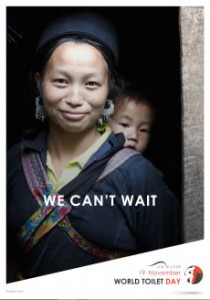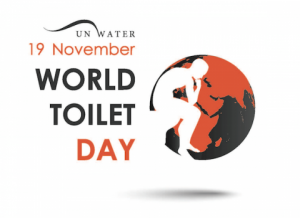Don’t Underestimate the Importance of Toilets
Nov 18th, 2014 | By admin | Category: Other ResourcesBy Suzanne York, www.howmany.org
Worldwide, 2.5 billion people lack access to proper sanitation. That is nearly 40% of the world’s population. In fact, more people have a cell phone than a toilet.That is why World Toilet Day is recognized on November 19th. A project of UN Water, the day is meant “to raise awareness about all people who do not have access to a toilet – despite the human right to water and sanitation.” The UN states that “It is a chance for advocacy aimed at policy makers and key stakeholders. It’s a chance to spread the word about the sanitation crisis and what can be done to address it.”
Fast Facts on Sanitation
- 1 billion people still defecate in the open;
- 1,600 children die per day of diarrhoea that’s largely preventable through clean toilets, safe water and good hygiene;
- 15% of the world’s population doesn’t have access to a toilet at all, forcing them to defecate in the open;
- 25% of the world’s population is affected by intestinal worms, entirely preventable through safe, clean toilets and improved hygiene;
- 1 in 3 women do not have access to safe toilets.
Clean India Campaign
Safety is a huge issue, something most people in the developed world take for granted. Women who have to relieve themselves outside and in the open risk rape, abuse and other threats to their safety, including wild animals.
Narendra Modi, India’s new Prime Minister, has started a campaign to stop open defecation. More than 620 million people in India defecate outdoors — a much higher rate than in poorer countries like Bangladesh or those in sub-Saharan Africa.
Modi’s Clean India Campaign aims to make India ‘clean’ by 2019. It calls for the elimination of open defecation, which Modi called a “blot on society”, especially for women and young girls (the campaign also focuses on ending littering).
India presents a challenge for toilet use. Two Indian journalists – Ankita Rao and Vivekananda Nemana – writing in the New York Times, interviewed experts on sanitation and toilet use. Arundati Muralidharan, a senior research fellow at the Public Health Foundation of India, said “It’s not enough to build toilets, because even in households that have their own latrines, people do not use them.” “There are massive social, cultural norms and behavioral practices that we are looking to influence.”
Payal Hathi, who undertook a survey of 22,000 people in five Indian states on sanitation habits, found that 40 percent of households with a working latrine have at least one member who continues to defecate outdoors. Hathi said that in rural India, “defecating far away from the home is considered cleaner than using toilets.”
Less than a third of India’s 1.2 billion people have access to sanitation and more than 186,000 children under five die every year from diarrhoeal diseases caused by unsafe water and poor sanitation, according to WaterAid.
A Good Return on InvestmentAccording to the World Toilet Organization, every $1 spent on water and sanitation generates returns of $8 in saved time, increased productivity and reduced health costs.
More importantly, clean and safe toilets help keep more girls in school and increase attendance rates. Too many girls miss out on education just because of the lack of a clean and safe toilet.
Access to a safe, clean toilet should be a basic right for everyone. UNICEF has created an online game to experience the struggle over something most people take for granted. Play the UNICEF Toilet Trek game and support World Toilet Day by going to the Toilet Trek website.
On a lighter note, check out the World Toilet Organization’s Ten Things You Can Do for UN World Toilet Day (though I recommend skipping the ‘toilet selfie’).
Suzanne York is a senior writer with the Institute for Population Studies.


